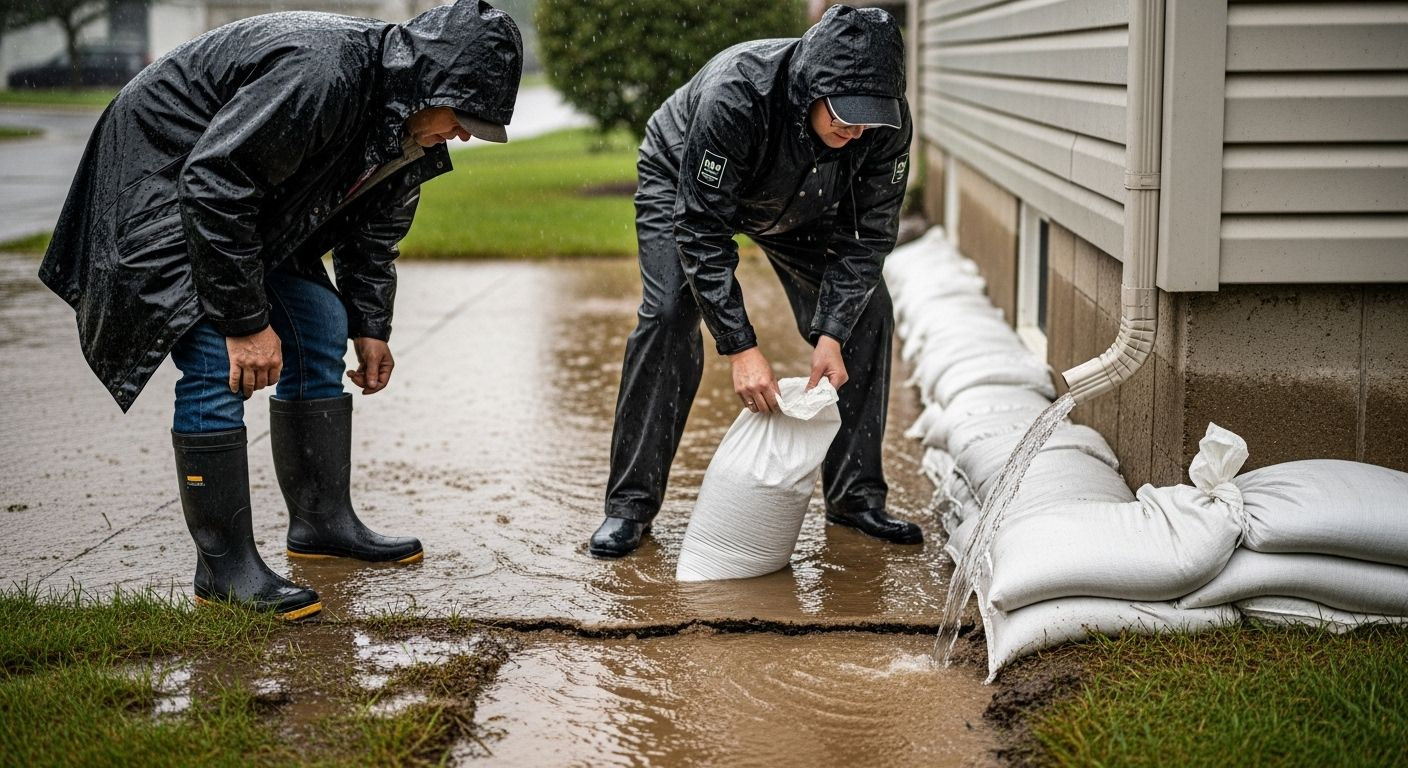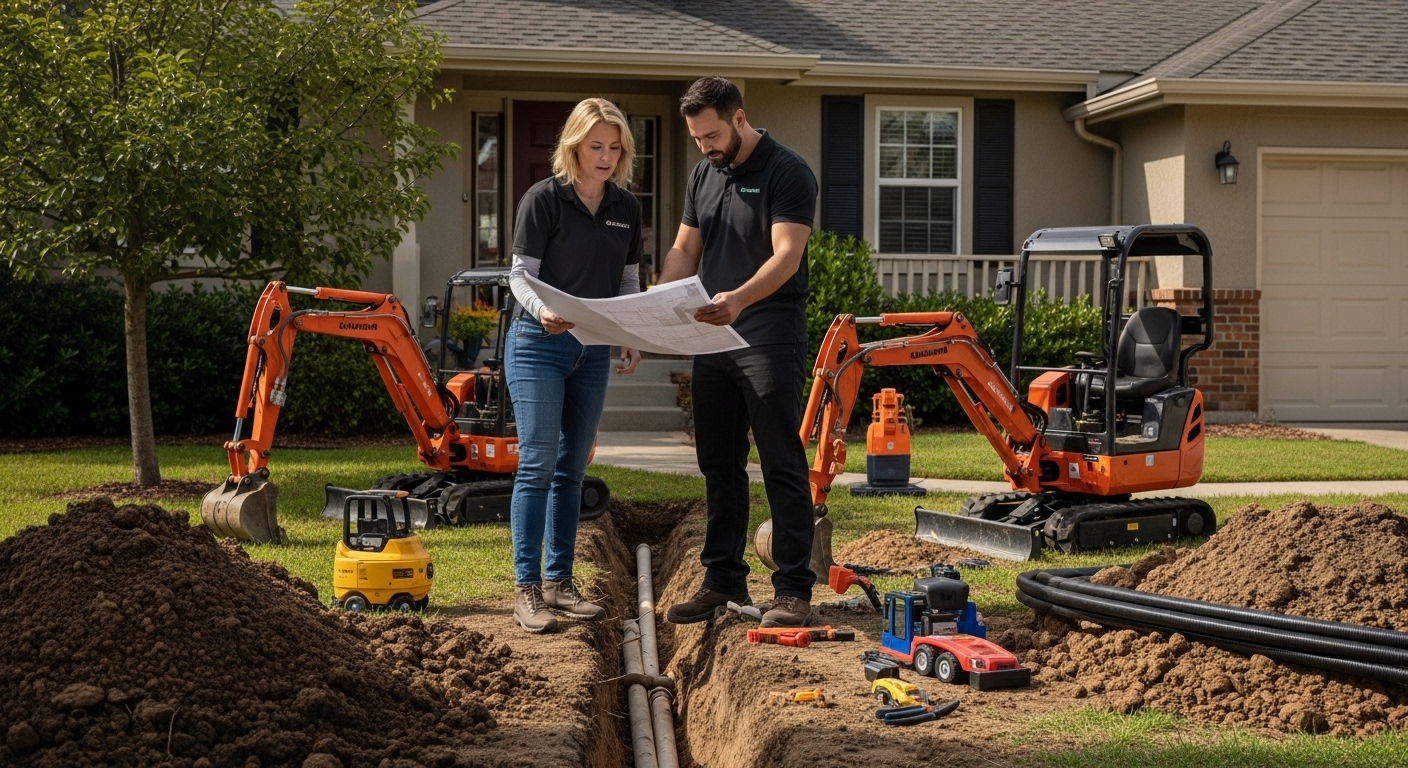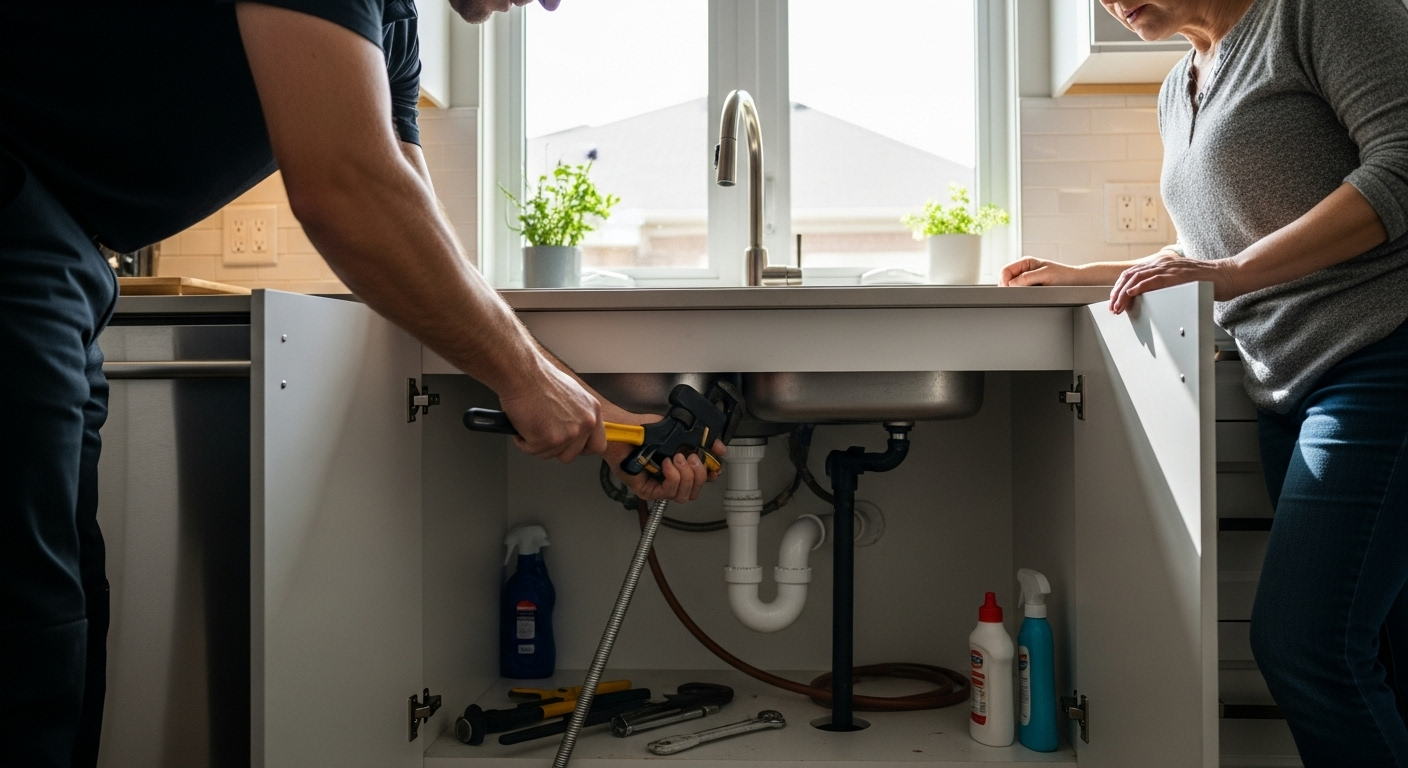Understanding the Causes of Basement Flooding

Basement flooding is a nightmare for any homeowner and it turns a dry, cozy space into a danger zone for both property and health. Most people worry about a soaked carpet or ruined boxes but there is more at stake than soggy floors. Continuous basement moisture can cause concrete to erode and wood to rot, leading to lasting structural damage and dangerous mould growth. What surprises many is that even a tiny crack in the foundation or one intense burst of rain can set off a chain reaction that threatens your entire home, inside and out.
Table of Contents
Quick Summary
| Takeaway | Explanation |
|---|---|
| Prevent Water Intrusion | Address minor foundation cracks to limit water seepage into basements. |
| Understand Soil Composition | Identify soil types around your home, as clay-heavy soils retain water and increase flooding risks. |
| Manage Drainage Systems | Ensure your gutters and yard grading effectively direct water away from your foundation. |
| Plan for Extreme Weather | Recognize increased rainfall intensity and adjust your home’s drainage strategies accordingly. |
| Conduct Regular Inspections | Schedule professional assessments to identify structural vulnerabilities and improve flood prevention measures. |
What is Basement Flooding and Why Does It Occur?
Basement flooding is a serious residential issue where water accumulates inside the lowest level of a home, potentially causing extensive damage to property, structural integrity, and personal belongings. Unlike occasional dampness, basement flooding involves significant water intrusion that can quickly transform a dry space into a waterlogged zone.
The Mechanics of Water Invasion
Basement flooding occurs through multiple potential pathways, each representing a unique challenge for homeowners. Water can enter basements through several critical mechanisms:

- Foundation Cracks : Small structural breaks in basement walls or floors that allow water to seep through
- Overwhelmed Municipal Drainage Systems : City sewer systems that cannot handle excessive rainfall or snowmelt
- Groundwater Pressure : High water tables that push moisture through porous foundation materials
The primary culprits behind basement flooding often involve a combination of environmental conditions and infrastructure limitations. During heavy rainfall or rapid snowmelt, residential drainage systems can become quickly overwhelmed. When municipal sewers reach capacity, water seeks alternative paths – frequently finding its way into basement spaces through existing vulnerabilities.
Understanding Water Pressure Dynamics
Water follows the path of least resistance, and basements represent a natural low point in residential structures. Hydrostatic pressure from saturated soil surrounding foundation walls can force water through microscopic openings, creating persistent moisture problems. learn more about preventing water intrusion to protect your property from potential flooding risks.
Geographical location, local topography, and specific soil composition significantly influence basement flooding potential. Homes situated in areas with high water tables or regions experiencing frequent heavy precipitation face increased risks. Clay-heavy soils, which drain slowly and retain moisture, can compound these challenges by maintaining consistent water pressure against foundation walls.
Recognizing the complex nature of basement flooding helps homeowners understand that prevention requires a multifaceted approach involving proper drainage, structural maintenance, and proactive water management strategies.
The Role of Water Drainage and Soil Saturation
Water drainage and soil saturation are critical factors that determine the likelihood of basement flooding, creating a complex interplay between environmental conditions and structural vulnerabilities. Understanding how water moves through and around residential foundations provides homeowners with essential insights into preventing moisture intrusion.
Soil Composition and Water Movement
Soil acts as a dynamic water transportation system, with different compositions dramatically affecting moisture retention and drainage capabilities. Clay-based soils , which are common in many regions, present significant challenges due to their low permeability and high water retention properties. These dense soil types can create substantial water pressure against foundation walls, increasing basement flooding risks.
Key characteristics of soil drainage include:
- Permeability : The ability of soil to allow water to pass through
- Water Retention : How much moisture soil can hold before becoming saturated
- Compaction : The density of soil which impacts its drainage capabilities
Hydrostatic Pressure and Foundation Interactions
Hydrostatic pressure represents the fundamental mechanism driving water intrusion into basements. When soil surrounding a foundation becomes saturated, water seeks paths of least resistance, exploiting even microscopic openings in foundation walls or floor slabs. explore our comprehensive waterproofing strategies to understand how professional interventions can mitigate these risks.
Topographical considerations play a significant role in drainage dynamics. Properties situated in low-lying areas or regions with high water tables face elevated risks of basement flooding. Natural landscape contours, combined with local precipitation patterns, create unique drainage challenges that require tailored solutions.
Proper water management involves a holistic approach that addresses surface drainage, underground water movement, and structural integrity. Homeowners must consider grading around their foundation, ensuring water flows away from the building, installing effective gutter systems, and maintaining proper landscape drainage to minimize soil saturation and potential basement flooding risks.
Understanding Weather Patterns and Their Impact on Flooding
Weather patterns play a crucial role in determining basement flooding risks, transforming seemingly benign precipitation events into potential home catastrophes. Modern climate dynamics have increased the frequency and intensity of rainfall events, creating unprecedented challenges for residential drainage systems and infrastructure.
Rainfall Intensity and Urban Infrastructure
Rainfall intensity represents a critical factor in basement flooding potential. Short-duration, high-volume precipitation events can overwhelm municipal drainage systems and residential infrastructure faster than traditional water management strategies can respond. Urban environments compound this risk through extensive impervious surfaces like concrete and asphalt, which prevent natural ground absorption and rapidly channel water toward low-lying areas.
Key characteristics of problematic rainfall patterns include:
- Concentrated Precipitation : Short bursts of extremely heavy rainfall
- Prolonged Storm Systems : Extended periods of consistent precipitation
- Rapid Snowmelt : Sudden temperature increases causing rapid snow conversion
Climate Change and Extreme Weather Connections
Climate change has significantly altered traditional weather predictability, introducing more frequent extreme precipitation events. Warmer atmospheric temperatures enable air to hold more moisture, resulting in more intense and unpredictable rainfall scenarios. understand how weather impacts your home’s drainage to develop proactive protection strategies.
Regional topography further influences flooding risks. Low-lying areas, regions with high water tables, and locations near rivers or lakes experience heightened vulnerability. Urban development has further complicated natural water drainage patterns, reducing ground absorption capabilities and increasing surface runoff.
Homeowners must recognize that modern weather patterns demand adaptive water management approaches. Understanding local precipitation trends, investing in robust drainage infrastructure, and implementing strategic landscape design can significantly mitigate basement flooding risks in an increasingly unpredictable climate environment.
Identifying Structural Issues That Contribute to Flooding
Structural vulnerabilities represent complex pathways through which water can infiltrate residential basements, transforming seemingly solid foundations into potential entry points for moisture. Understanding these structural weaknesses becomes crucial in developing comprehensive flood prevention strategies.
Foundation Vulnerabilities and Water Entry Points
Foundation cracks serve as primary mechanisms for water intrusion, ranging from microscopic hairline fractures to significant structural breaches. These openings emerge through multiple mechanisms: natural settling, soil pressure, concrete shrinkage, and geological movement. Even seemingly insignificant foundation imperfections can become substantial water entry points during sustained precipitation events.
Key structural vulnerabilities include:
- Wall Cracks : Horizontal and vertical fissures in foundation walls
- Floor Slab Openings : Gaps or breaks in concrete basement floors
- Joint Connections : Weak seals between walls and floor surfaces
Drainage System Structural Limitations
Residential drainage infrastructure represents another critical component in basement flooding risks. Aging or improperly designed drainage systems struggle to manage increasing water volumes, particularly during intense weather events. explore comprehensive waterproofing solutions to understand how professional interventions can address these structural challenges.
Municipal sewer systems and private drainage infrastructure interact in complex ways. Outdated pipe materials, insufficient pipe diameters, and legacy infrastructure design contribute to systemic vulnerabilities. Clay pipes, common in older neighbourhoods, are particularly susceptible to root intrusion, cracking, and structural degradation that compromise water management capabilities.
Homeowners must recognize that structural issues represent dynamic challenges requiring proactive assessment and strategic intervention. Regular professional inspections, understanding local geological conditions, and implementing targeted drainage improvements can significantly mitigate basement flooding risks associated with structural vulnerabilities.

Long-Term Effects of Basement Flooding on Homes and Health
Basement flooding transcends immediate water damage, presenting profound long-term consequences for residential structures and occupant health. The aftermath of water intrusion extends far beyond visible surface damage, creating complex and potentially hazardous environmental conditions that can persist for years.
Structural Deterioration and Material Compromise
Water damage fundamentally weakens structural integrity , initiating a progressive deterioration process that compromises building materials. Continuous moisture exposure accelerates concrete and wood decay, causing foundation weakening, wood rot, and metal corrosion. Persistent dampness creates microscopic structural changes that incrementally reduce a home’s resilience and market value.
Key long-term structural risks include:
- Foundation Degradation : Continuous moisture causing concrete erosion
- Wood Structural Decay : Timber framing susceptibility to rot and fungal growth
- Metal Component Corrosion : Accelerated rusting of support structures
Health Risks and Environmental Contamination
Moisture-rich environments become breeding grounds for biological hazards, particularly mold and bacterial proliferation. Prolonged dampness transforms basements into complex microbial ecosystems that generate significant respiratory and allergenic risks. learn about protecting your home’s health and understanding these critical environmental challenges.
Mold spores represent particularly insidious health threats, capable of causing chronic respiratory conditions, allergic reactions, and immune system complications. Children, elderly individuals, and those with pre-existing respiratory conditions face heightened vulnerability to these environmental contaminants.
Homeowners must recognize basement flooding as more than a temporary inconvenience. The cumulative impact of water intrusion represents a complex challenge requiring comprehensive, proactive management strategies that address both immediate water removal and long-term structural preservation and health protection.
Protect Your Basement and Your Peace of Mind with DrainWorks Plumbing
Are you worried about cracks, drainage issues or unpredictable weather turning your basement into a problem zone? If you found this article while searching for answers about basement flooding, you probably know how costly and stressful it can be. A wet or flooded basement is more than an inconvenience. It threatens your home’s foundation, your belongings and even your family’s health. With persistent hydrostatic pressure, saturated clay soils and foundation cracks all working against you, simply hoping for the best is not enough.

Now is the best time to upgrade your home’s protection. With over 30 years of experience in Toronto, the team at DrainWorks Plumbing brings proven expertise in residential waterproofing, drain service and all aspects of flood prevention. Our clear pricing, trusted technicians and award-winning service mean you get lasting results without surprises. If you are ready to take action on waterproofing, foundation repairs or any drainage concern, visit DrainWorks Plumbing today and book your same day service. Safeguard your home against basement flooding before the next storm arrives.
Frequently Asked Questions
What are the main causes of basement flooding?
Basement flooding can be caused by foundation cracks, overwhelmed municipal drainage systems, and groundwater pressure. These factors can allow water to seep into basements during heavy rain or rapid snowmelt.
How does soil composition affect basement flooding?
Soil type significantly impacts water drainage. Clay-heavy soils, for example, retain moisture and create hydrostatic pressure against foundation walls, increasing the likelihood of water intrusion into basements.
What role does drainage play in preventing basement flooding?
Proper drainage around your home is essential in preventing basement flooding. Effective gutter systems, proper grading of the landscape, and well-maintained drainage infrastructure help direct water away from the foundation.
How can I identify structural issues that may cause flooding in my basement?
Look for visible signs such as wall and floor cracks, gaps in foundation joints, or degraded drainage systems. Regular inspections can help identify vulnerabilities before they become significant issues.













